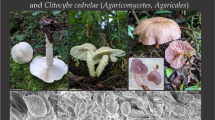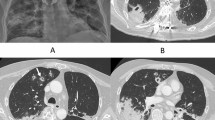Abstract
Hormographiella-like strains, isolated from different natural substrates and producing sclerotia and occasionally basidiomata of Coprinus cinereus, were compared morphologically and using molecular techniques with clinical strains of Hormographiella aspergillata and H. verticillata. Analysis of restriction fragment length polymorphisms of ribosomal and mitochondrial-like DNA confirmed interspecific differences between H. aspergillata and H. verticillata, supporting the morphological data, and helped demonstrate that H. aspergillata is the anamorph of C. cinereus. The latter was confirmed also by crossing tests. The analysis of the mtDNA restriction profiles revealed intraspecific variability in C. cinereus, which allowed differentiation of clinical and environmental strains. Due to the implication of C. cinereus and Hormographiella in human opportunistic infections, the antifungal susceptibility test is included. Results show that all strains were susceptible to miconazole, itraconazole and ketoconazole but not to flucytosine and fluconazol. Susceptibility against amphotericin B was variable; while H. verticillata was susceptible, four out of seven C. cinereus strains tested were resistant.
Similar content being viewed by others
References
Abbott SP & Sigler L (1994) Filamentous basidiomycetes from clinical sources. Proc. XII Congr. ISHAM Adelaide pp D133
Batista AD, Maia JA & Singer R (1955) Basidioneuromycosis on man. An. Soc. Biol. Pernambuco 13: 52–60.
Carlile MJ & Watkinson SC (1994) The fungi. Academic Press, London
Catalano P, Lawson W, Bottone E & Lebenger J (1990) Basidiomycetous (mushroom) infection of the maxillary sinus. Otolarhyngol. Head Neck Surg. 102: 183–185
Ciferri R, Batista AC & Campos S (1956) Isolation of Schizophyllum commune from a sputum. Atti Inst. Bot. Lab. Crittogam. Univ. Pavia 14: 3–5
Crous PW, Janse BJH, Victor D, Marais GF & Alfenas AC (1983) Characterization of some Cylindrocladium species with three-septate conidia using morphology, isoenzyme banding patterns and DNA polymorphisms. System. Appl. Microbiol. 16: 266–273
De Hoog S & Guarro J (Eds) (1995) Atlas of Clinical Fungi. Centraalbureau voor Schimmelcultures, Baarn
De Vries GA, Kemp RFO & Speller DCE (1971) Endocarditis caused by Coprinus delicatulus. Proc. 5th Congr. ISHAM Paris, pp 185–186
Emmons CW (1954) Isolation of Myxotrichum and Gymnoascus from lungs of animals. Mycologia 46: 334–338
Estruch JJ, Antuña C, Ferrer S & Ramón D (1989) Aislamiento de DNA genómico de Trichophyton mentagrophytes. Rev. Ibér. Micol. 6: 62–66
Greer DL (1977) Basidiomycetes as agents of human infections: a review. Mycopathologica 14: 67–70
Guarro J, Gené J, De Vroey C & Guého E (1992) Hormographiella, a new genus of hyphomycetes from clinical sources. Mycotaxon 45: 179–190
Guillamón JM, Cano J, Ramón D & Guarro J. Molecular differentiation of Keratinomyces (Trichophyton) species. Antonie van Leeuwenhoek (in press)
Henrion B, Chevalier G & Martin F (1994) Typing truffle species by PCR amplification of the ribosomal DNA spacers. Mycol. Res. 98: 37–43
Hughes SJ (1953) Conidiophores, conidia and classification. Can. J. Bot. 31: 577–659
Kern ME & Uecker FA (1986) Maxillary sinus infection caused by the homobasidiomycetous fungus Schizophyllum commune. J. Clin. Microbiol. 23: 1001–1005
Kligman A (1950) A basidiomycete probably causing onychomycosis. J. Invest. Dermatol. 14: 67–70
McGinnis MR (1983) Detection of fungi in cerebrospinal fluid. Am. J. Med. 75 (IB): 129–138
Molina FI, Inoue T & Jong SC (1992) Restriction polymorphisms in the internal transcribed spacers and 5.8S rDNA of Saccharomyces. Curr. Microbiol. 25: 251–255
Nishio T, Kawasaki M & Ishizaki H (1992) Phylogeny of the genera Trichophyton using mitochondrial DNA analysis. Mycopathologia 117: 127–132
Orton PD & Watling R (1979) British fungus flora. Agarics and Boleti 2. Coprinaceae part 1, Coprinus. Roy. Bot. Gard. Edinburgh, Edinburgh
Restrepo A, Greer DL, Robledo M, Osorio O & Mondragón H (1973) Ulceration of the palate caused by a basidiomycete Schizophyllum commune. Sabouraudia 11: 201–204
Rosenthal J, Katz R, Dubois DB, Morrissey A & Machicao A (1992) Chronic maxillary sinusitis associated with the mushroom Schizophyllum commune in a patient with AIDS. Clin. Infect. Dis. 14: 46–48
Sambrook J, Fritsch EF & Maniatis T (1989) Molecular cloning: a laboratory manual, 2nd ed. Cold Spring Harbor Lab. Press, NY
Sigler L & Carmichael JW (1976) Taxonomy of Malbranchea and some other hyphomycetes with arthroconidia. Mycotaxon 4: 349–488
Speller DCE & Maclver AG (1971) Endocarditis caused by a Coprinus species: a fungus of the toadstool group. J. Med. Microbiol. 4: 370–374
Straatsma G, Samson RA, Olijnsma TW, Op den Camp HJM, Gerrits JPG & Van Griensven LJLD (1994) Ecology of thermophilic fungi in mushroom compost, with emphasis on Scytalidium thermophilum and growth stimulation of Agaricus bisporus mycelium. Appl. Environ. Microbiol. 60: 454–458
Thomas V, Rutherford MA & Bridge PD (1994) Molecular differentiation of two races of Fusarium oxysporum special form cubense. Lett. Appl. Microbiol. 18: 193–196
Tubaki K (1981) Hyphomycetes-their perfect-imperfect connections-. J. Cramer, Vaduz
White TJ, Bruns T, Lee S & Taylor J (1990) Amplification and direct sequencing of fungi ribosomal RNA genes for phylogenetics. In: Innis MA, Gelfand DH, Sninsky JJ & White TJ (Eds) PCR protocols. A guide to methods and applications (pp 315–322). Acad. Press, San Diego
Author information
Authors and Affiliations
Rights and permissions
About this article
Cite this article
Gené, J., Guillamon, J.M., Guarro, J. et al. Molecular characterization, relatedness and antifungal susceptibility of the basidiomycetous hormographiella species and Coprinus cinereus from clinical and environmental sources. Antonie van Leeuwenhoek 70, 49–57 (1996). https://doi.org/10.1007/BF00393569
Received:
Accepted:
Issue Date:
DOI: https://doi.org/10.1007/BF00393569




